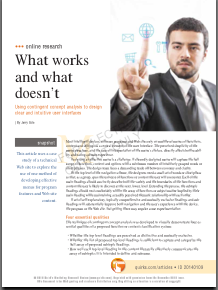Our website’s users say they can’t find what they’re looking for because the category headings in our navigation bar don’t clearly communicate the list of sub-topics found under each one… – Site Manager, Leading Software Development Firm
CONTINGENT CONTENT ANALYSIS: Q-CCA
MENU CLARITY AND USER EXPERIENCE (UX) RATINGS
Most intelligent devices, software programs and websites rely on multi-level menus of functions, content and settings as a central element of the user interface. The perceived simplicity of the menu structure, and the ease of interpretation of the menu’s choices, directly affects both the site’s or device’s usability and its ratings of user experience.
Designing an effective menu is a difficult challenge: the design team faces a demanding trade-off between the economy of choices offered and the clarity of the options presented…
Contingent Content Analysis (q-CCA) was developed as a method for visually demonstrating the relative strengths and weaknesses of a menu-driven function or content classification system. A card sort process paired with a graphic analysis of users’ choices quickly reveals which headings are effectively communicating the full array of their second level options, and which headings are creating confusion or causing problems of interpretation…
An article providing a full description of our Contingent Content Analysis technique appeared in the January 2014 issue of Quirk’s Marketing Research Review. Download a copy of the article below:
Download our Contingent
Content Analysis PDF



